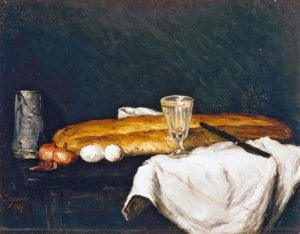R082 – Le Pain et les œufs, 1865 (FWN704)
Pavel Machotka
(Cliquer sur l’image pour l’agrandir)
Le Pain et les oeufs révèle l’influence des trois ans d’étude de la peinture que Cézanne a passés à Paris. Préparé probablement pour le Salon de 1865 (et refusé), la palette brun sur noir du tableau fait référence en premier à Manet, et à travers Manet aux peintres espagnols ; le pain est d’un riche rouge-brun contre le gris froid de la boîte de lait, et les touches diagonales de la surface du pain sont parallèles à la rayure rose du torchon et au couteau. Tout cela est réfléchi et parfaitement réalisé, mais aussi traditionnel et soigneux, et Cézanne semble avoir hésité entre placer les objets plus hauts, pour faire plus grande masse, ou plus bas, pour un contraste plus frappant avec le fond noir ; en tout cas il arrive à un compromis traditionnel. On a l’impression d’un peintre qui a essayé de satisfaire aux exigeances du Salon plutôt qu’à ses propres désirs (une attitude qu’il ne tardera pas à abandonner).
Source: Machotka, Cézanne: La Sensation à l’oeuvre.
Le Pain et les oeufs reveals the influence of the first three years of study in Paris. It was probably submitted to the Salon of 1866 with the Portrait d’Antony Valabrègue and it, too, was rejected; whatever the reasons were, they could not have been the same, because the still life is cautious in both color and composition. Its brown-on-black palette makes a reference primarily to Manet, and through Manet to the Spanish painters; the bread is a rich red-brown against the cool grey of the milk can, and diagonal brushstrokes in the surface of the bread parallel the pink stripe in the napkin and the knife. All of this is thoughtful and perfectly competent, but also conservative and careful, and Cézanne appears to waver between placing the objects higher, for greater mass, or lower, for a more striking contrast with the black space; in any case, he reaches a timid compromise.
Source : Machotka, Cézanne : The Eye and the Mind.



Vous devez être connecté pour poster un commentaire.